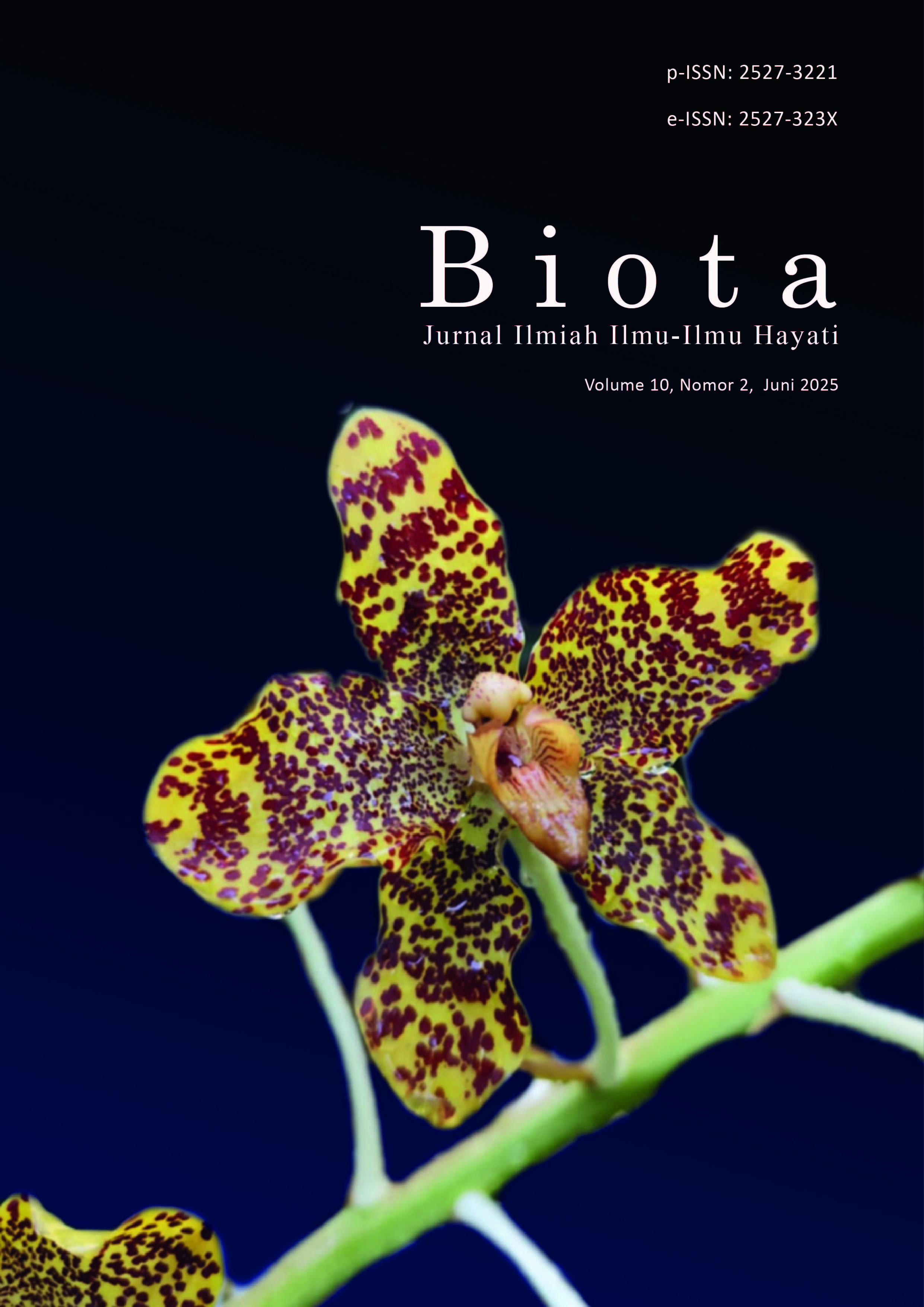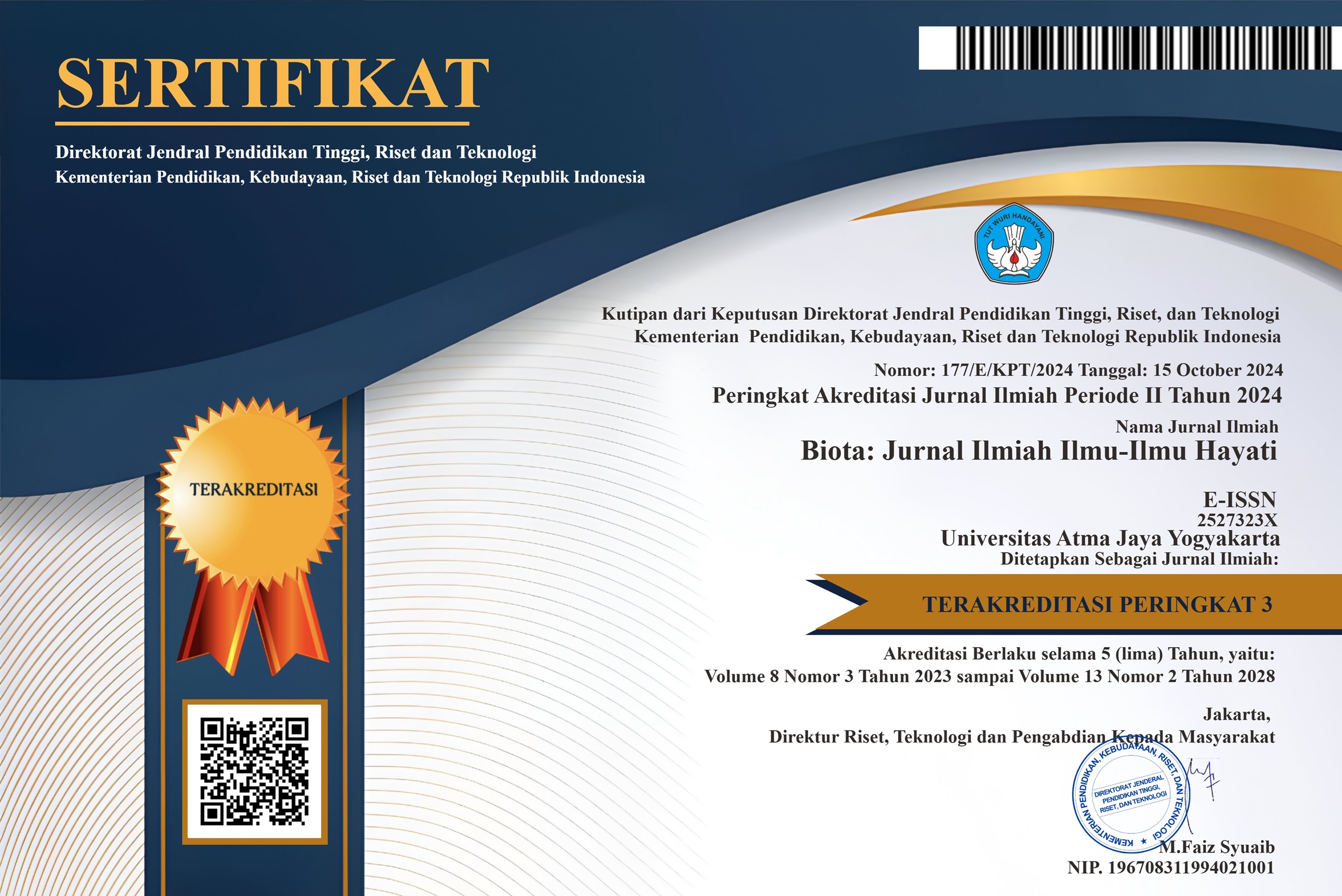Sago Starch-Lipid Complex Formation under Varying Fatty Acid Concentrations for Emulsion Stability Improvement
DOI:
https://doi.org/10.24002/biota.v10i2.11610Keywords:
Sago, starch-lipid complex, fatty acid, concentration, emulsionAbstract
The amount of fatty acids added is critical in creating starch-lipid complexes, which can affect their formation and properties. To use the complex to stabilize oil-in-water emulsion systems, this study intends to assess the effects of fatty acid concentrations on the effectiveness of starch-lipid complex formation and the properties of the resulting complexes. Ultrasonication was used to produce starch-lipid complexes from sago starch with different fatty acid contents (10, 12.5, 15, 17.5, and 20%) for the study. The results demonstrated that adding fatty acids up to 15% concentration significantly improved the water absorption capacity (WAC). In contrast, increasing the complexing index (CI), relative crystallinity (RC), oil absorption capacity (OAC), and contact angle of sago starch-lipid complexes. When the concentration of fatty acids was raised over 15%, the properties of the starch-lipid complex did not change considerably. A concentration of 15% with CI 67.07%, RC 37.94%, WAC 1.352 mL/g, OAC 1.370 mL/g, contact angle 70.82 °, emulsion capacity 36.72%, and emulsion stability 35.80% was shown to be the optimal amount of fatty acids for the production of sago starch-lipid complex. Emulsion stability and capacity can be maintained using a sago starch-lipid complex with an ideal fatty acid concentration of 15%.
References
Akbari, S., & Nour, A. H. (2018). Emulsion types, stability mechanisms and rheology: A review. International Journal of Innovative Research and Scientific Studies 1(1): 11–17.
BeMiller, J., & Whistler, R. (2009). Starch Chemistry and Technology (3rd ed.). Academic Press: Cambridge.
Chao, C., Huang, S., Yu, J., Copeland, L., Yang, Y., & Wang, S. (2024). The influence of short-range molecular order in gelatinized starch on the formation of starch-lauric acid complexes. International Journal of Biological Macromolecules 260(4): 129526.
Dewi, A. M. P. (2023). Sifat Fisikokimia Active Biodegradable Film Pati Sagu (Metroxylon Sp) Termodifikasi Heat Moisture Treatment-Oktenil Suksinilasi Dengan Penambahan Ekstrak Kulit Kayu Akway (Drymis Piperita Hook F.) (Doctoral Disertation). Universitas Gadjah Mada, Yogyakarta.
Dewi, A. M. P., Santoso, U., Pranoto, Y., & Marseno, D. W. (2022a). Dual Modification of Sago Starch via Heat Moisture Treatment and Octenyl Succinylation to Improve Starch Hydrophobicity. Polymers 14(6): 1–17.
Dewi, A. M. P., Santoso, U., Pranoto, Y., & Marseno, D. W. (2023). Optimizing reaction condition of octenyl succinic anhydride on heat-moisture-treated sago starch and its application for biodegradable film. Food Science and Technology 43: 1–9.
El-Fakharany, E. M., & Redwan, E. M. (2019). Protein-lipid complexes: Molecular structure, current scenarios and mechanisms of cytotoxicity. RSC Advances 9(63): 36890–36906.
Farooq, A. M., Dhital, S., Li, C., Zhang, B., & Huang, Q. (2018). Effects of palm oil on structural and in vitro digestion properties of cooked rice starches. International Journal of Biological Macromolecules 107(PartA): 1080–1085.
Feng, T., Zhuang, H., Chen, F., Campanella, O., Bhotpakar, D., Carignano, M. A., & Park, S. H. (2018). Starch-Lipid and Starch-Protein Complexes and Their Application. In Z. Jin (Ed.), Functional Starch and Applications in Food. Springer: Singapore.
Garcia, M. C., Pereira-Da-Silva, M. A., Taboga, S., & Franco, C. M. L. (2016). Structural characterization of complexes prepared with glycerol monoestearate and maize starches with different amylose contents. Carbohydrate Polymers 148: 371–379.
Hong, L. F., Cheng, L. H., Gan, C. Y., Lee, C. Y., & Peh, K. K. (2018). Evaluation of starch propionate as emulsion stabiliser in comparison with octenylsuccinate starch. LWT - Food Science and Technology, 91: 526–531.
Hong, L. F., Cheng, L. H., Lee, C. Y., & Peh, K. K. (2015). Characterisation of physicochemical properties of propionylated corn starch and its application as stabiliser. Food Technology and Biotechnology 53(3): 278–285.
Kang, X., Liu, P., Gao, W., Wu, Z., Yu, B., Wang, R., Cui, B., Qiu, L., & Sun, C. (2020). Preparation of starch-lipid complex by ultrasonication and its film forming capacity. Food Hydrocolloids 99 105340.
Karkalas, J., Ma, S., Morrison, W. R., & Pethrick, R. A. (1995). Some factors determining the thermal properties of amylose inclusion complexes with fatty acids. Carbohydrate Research 268(2 233–247.
Lee, H. S., Kim, K. H., Park, S. H., Hur, S. W., & Auh, J. H. (2020). Amylose-lipid complex as a fat replacement in the preparation of low-fat white pan bread. Foods 9(2 1–12.
Li, X., Gao, X., Lu, J., Mao, X., Wang, Y., Feng, D., Cao, J., Huang, L., & Gao, W. (2019). Complex formation, physicochemical properties of different concentration of palmitic acid yam (Dioscorea pposita Thunb.) starch preparation mixtures. 101 130–137.
Liu, Q., Luo, H., Liang, D., Zheng, Y., Shen, H., & Li, W. (2024). Effect of electron beam irradiation pretreatment and different fatty acid types on the formation , structural characteristics and functional properties of starch-lipid complexes. Carbohydrate Polymers 337 122187.
Liu, Y., Chen, J., Luo, S., Li, C., Ye, J., Liu, C., & Gilbert, R. G. (2017). Physicochemical and structural properties of pregelatinized starch prepared by improved extrusion cooking technology. Carbohydrate Polymers 175 265–272.
Lu, X., Liu, H., & Huang, Q. (2020). Fabrication and characterization of resistant starch stabilized Pickering emulsions. Food Hydrocolloids 103 105703.
Majzoobi, M., Kaveh, Z., & Farahnaky, A. (2016). Effect of acetic acid on physical properties of pregelatinized wheat and corn starch gels. Food Chemistry 196 720–725.
Roman, L., Walker, M. R., Detlor, N., Best, J., & Martinez, M. M. (2022). Pregelatinized Drum-Dried Wheat Starch of Different Swelling Behavior as Clean Label Oil Replacer in Oil-in-Water Emulsions. Foods 11(14 1–18.
Santoso, B., Sarungallo, Z. L., & Dewi, A. M. P. (2021). Physicochemical and functional properties of spineless, short-spines, and long-spines sago starch. Biodiversitas 22(1 137–143.
Tang, M. C., & Copeland, L. (2007). Analysis of complexes between lipids and wheat starch. Carbohydrate Polymers 67(1 80–85.
Tethool, E. F., Jading, A., & Santoso, B. (2012). Characterization of Physicochemical and Baking Expansion Properties of Oxidized Sago Starch Using Hydrogen Peroxide and Sodium Hypochlorite Catalyzed By UV Irradiation. Food Science and Quality Management 10 1–11.
Tethool, E. F., Raharjo, S., Pranoto, Y., & Supriyadi, S. (2025). Investigation of Pregelatinized Sago Starch-Decanoic Acid Complex by Ultrasonication and its Potential to Stabilize Oil-In-Water Emulsion. Trends in Sciences 22(3): 9241
Wang, S., Wang, S., Chao, C., Cai, J., Niu, B., & Copeland, L. (2020). Starch – lipid and starch – lipid – protein complexes : A comprehensive review 19(3): 1056–1079
Wang, Y., Yan, Q., Li, Z., Chen, W., Gu, W., & Zhang, W. (2024). Microstructure and emulsifying properties of rice starch-fatty acid complexes prepared bu ultra-high pressure teratment. Food Hydrocolloid 158: 110486.
Yang, Y., Fang, Z., Chen, X., Zhang, W., Xie, Y., Chen, Y., Liu, Z., & Yuan, W. (2017). An overview of pickering emulsions: Solid-particle materials, classification, morphology, and applications. Frontiers in Pharmacology 8 1–20.
Yulianingsih, R., & Gohtani, S. (2019). Dispersion characteristics of pregelatinized waxy rice starch and its performance as an emulsifier for oil-in-water emulsions: Effect of gelatinization temperature and starch concentration. Food Hydrocolloids 95 476–486.
Zhang, G., Ao, Z., & Hamaker, B. R. (2006). Slow digestion property of native cereal starches. Biomacromolecules 7(11 3252–3258.
Downloads
Published
How to Cite
Issue
Section
License
Copyright (c) 2025 Eduard Fransisco Tethool, Yudi Pranoto, Sri Raharjo, Supriyadi Supriyadi

This work is licensed under a Creative Commons Attribution-NonCommercial 4.0 International License.
Authors who publish with Biota : Jurnal Ilmiah Ilmu-Ilmu Hayati agree to the following terms:
- Authors retain copyright and grant the Biota : Jurnal Ilmiah Ilmu-Ilmu Hayati right of first publication. Licensed under a Creative Commons Attribution-NonCommercial 4.0 International License that allows others to share the work with an acknowledgment of the work's authorship and initial publication in this journal.
- Authors are able to enter into separate, additional contractual arrangements for the non-exclusive distribution of the journal's published version of the work (e.g., post it to an institutional repository or publish it in a book), with an acknowledgment of its initial publication in Biota : Jurnal Ilmiah Ilmu-Ilmu Hayati, and as long as Author is not used for commercial purposes.













